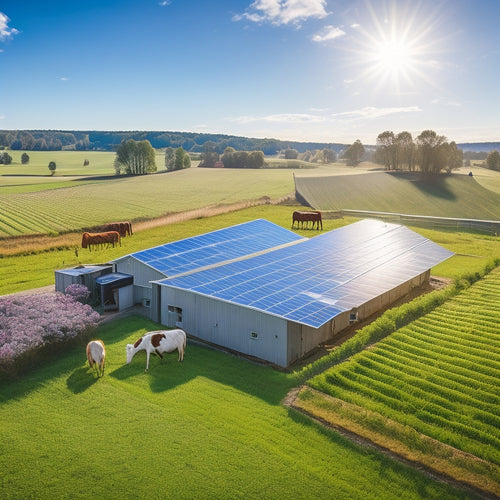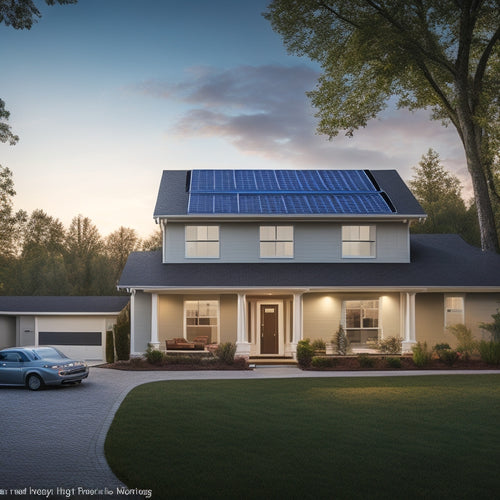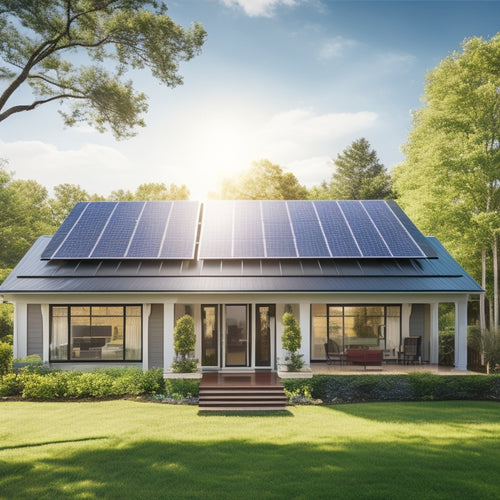
Off Grid Solar Installation
Share
You're taking the first step towards energy autonomy by considering an off-grid solar installation, which frees you from reliance on traditional power grids and unveils a renewable source of clean energy for your home or business. By optimizing energy efficiency and evaluating your energy demands, you can greatly reduce your energy bills. Maximum Power Point Tracking (MPPT) guarantees you're utilizing the most energy from your solar panels, while proper panel orientation and seasonal adjustments maximize energy conversion rates. As you investigate off-grid solar installations, you'll find out how to tailor a system that meets your unique needs, and reveal the secrets to achieving true energy independence.
The Essentials
- Off-grid solar installations provide energy autonomy, reducing reliance on traditional power grids and promoting a sustainable lifestyle.
- Optimizing energy efficiency is crucial, as it reduces energy consumption and leads to lower energy bills and increased savings.
- Maximum Power Point Tracking (MPPT) systems optimize energy harvesting by adjusting voltage for maximum solar panel performance in various weather conditions.
- Accurate sizing of off-grid solar systems requires daily power calculations, prioritizing essential loads for effective load management strategies.
- Effective panel orientation and seasonal adjustments maximize energy production, with ideal panel angles varying by latitude and season.
Zero Reliance on Grids
You're taking a vital step towards energy independence by opting for an off-grid solar installation, which means you won't rely on the grid for power.
This setup guarantees you have a renewable power source, reducing your carbon footprint and dependence on fossil fuels.
By utilizing self-sufficient solar solutions, you can break free from the constraints of traditional grid-based energy and tap into the power of the sun for your homes or businesses.
With this system, you'll generate clean energy and enjoy the freedom that comes with being self-sufficient.
Energy Independence Now
Freedom from the grid's constraints is the ultimate goal of off-grid solar installation, and energy independence is the key to releasing it.
By embracing an off-grid solar lifestyle, you're taking the first step towards energy autonomy. You'll be part of the independence movement, where individuals take control of their energy needs, relying on self-sustaining systems that utilize the power of the sun.
With DIY off-grid solar systems, you can break free from the constraints of traditional energy sources and enjoy unlimited clean energy, reducing your reliance on expensive generators or grid connection.
By doing so, you'll minimize your carbon footprint and take control of your own energy needs and independence. You'll enjoy sustainable living, free from the grid's limitations and uncertainties.
Eco-friendly choices like solar innovations will become an integral part of your daily life. You'll be producing your own clean energy, reducing your carbon footprint, and saving money on energy bills.
Energy independence now means you'll have the freedom to live life on your own terms. You can choose to live in remote areas, travel, or simply enjoy the peace of mind that comes with knowing you're not reliant on the grid.
Off-grid solar installation is the gateway to a life of energy independence, and it's within your reach.
Renewable Power Source
As you commence on your expedition towards energy independence, utilizing a renewable power source becomes paramount. You're no longer bound by the constraints of traditional energy grids, and instead, you're embracing a sustainable future. Renewable energy sources, such as solar power, have witnessed significant advancements in recent years, making them a viable alternative to fossil fuels.
| Renewable Energy Source | Benefits | Challenges |
|---|---|---|
| Solar Power | Zero emissions, abundant resource | Intermittent energy supply, high upfront costs |
| Wind Power | Low operating costs, scalable | Noise pollution, visual impact |
| Hydro Power | High energy conversion rate, reliable | Dependent on water resources, high infrastructure costs |
Lower Your Energy Bills
You can greatly reduce your energy consumption by optimizing your home's energy efficiency, which in turn will lower your energy bills.
By implementing simple changes, such as switching to energy-efficient appliances and lighting, you can cut your monthly costs.
Additionally, with a residential solar power system, you can generate renewable energy and save on electricity bills.
You'll be able to further reduce your energy bills by generating your own clean energy with your off-grid solar installation.
Reduce Energy Consumption
Reducing energy consumption is essential to maximizing the efficiency of your off-grid solar installation, since it directly impacts the size and cost of your system. The less energy you consume, the smaller your solar array can be, resulting in considerable cost savings.
To achieve this, you'll need to assess your energy usage and identify areas where you can reduce your consumption.
Start by replacing traditional incandescent bulbs with energy-efficient LED bulbs, which use considerably less energy to produce the same amount of light.
Next, consider upgrading to energy-efficient appliances, such as those with the ENERGY STAR certification. These appliances are designed to consume less energy while still providing the same level of performance.
Cut Monthly Costs
One notable advantage of reducing energy consumption is that it directly translates to lower energy bills. By installing an off-grid solar system, you'll greatly decrease your reliance on the grid, resulting in considerable monthly savings.
With solar power, you'll generate your own clean energy, reducing your dependence on traditional fossil fuels and the associated costs.
As you cut your energy consumption, you'll not only enjoy financial benefits but also contribute to a more sustainable future. The sustainability benefits of solar energy are undeniable, and by going off-grid, you'll be doing your part to reduce your carbon footprint.
In addition to the environmental advantages, there are financial incentives to evaluate. Many governments offer tax credits, rebates, and other incentives for individuals and businesses that invest in renewable energy systems.
Maximum Power Point Tracking
You'll want to guarantee your off-grid solar installation is fine-tuned for efficient energy harvesting, which is where Maximum Power Point Tracking (MPPT) comes in.
By leveraging a reliable home solar energy storage system, you can maximize your energy output and reduce reliance on the grid.
MPPT is a technique that tracks the ideal performance of your solar panels, adjusting the voltage to maximize energy output.
Efficient Energy Harvesting
In tandem with the solar panels, a Maximum Power Point Tracking (MPPT) system plays an essential role in optimizing energy harvesting by adapting to changing environmental conditions. You'll want to verify your MPPT system is compatible with your solar technology, as it will help maximize energy output and optimize energy storage.
| Environmental Condition | MPPT Response | Energy Harvesting Impact |
|---|---|---|
| Cloudy Skies | Adjusts voltage to optimize energy output | Increases energy harvesting by up to 20% |
| High Temperatures | Reduces voltage to prevent overheating | Maintains energy harvesting efficiency |
| Shading | Diverts energy to alternate paths | Minimizes energy loss by up to 15% |
| Low Light Conditions | enhances voltage to capture available energy | Increases energy harvesting by up to 10% |
Optimal Performance Tracking
Your solar array's peak performance hinges on precise Maximum Power Point Tracking (MPPT), which actively adjusts to the panel's ideal power point to squeeze out every last watt. This advanced technology guarantees you're getting the most out of your off-grid solar installation.
By continuously monitoring solar performance metrics, MPPT identifies the best power point and adjusts the system's voltage and current to match it. This results in maximum energy harvesting, even in variable weather conditions.
To further enhance your system, you can employ various system optimization strategies. One approach is to use multiple MPPT controllers, each dedicated to a specific section of your solar array. This allows each controller to focus on the unique performance characteristics of its assigned panels, assuring maximum energy production.
Additionally, you can implement smart monitoring systems that provide real-time data on your solar performance metrics, enabling you to make data-driven decisions to fine-tune your system.
Assess Your Energy Demands
You need to determine your energy usage patterns to design an off-grid solar installation that meets your specific needs, considering factors such as renewable energy kits and the energy efficiency of your appliances.
For example, if you're planning to live in a tiny home, you'll want to optimize your energy usage to minimize your reliance on the grid.
To do this, you'll need to calculate your daily power requirements, including the total watt-hours required by each appliance and device.
Energy Usage Patterns
Energy consumption habits shape the foundation of a successful off-grid solar installation. To achieve a sustainable off-grid lifestyle, you must understand your energy usage patterns. This involves analyzing your energy consumption trends to determine when and how you use energy throughout the day.
By doing so, you'll be able to identify opportunities to adopt sustainable living practices that reduce your environmental impact. A thorough understanding of your energy usage patterns will also help you optimize your solar system sizing, ensuring you have sufficient energy storage solutions to meet your needs.
This, in turn, will improve your solar panel efficiency and reduce your reliance on grid alternatives. Additionally, by implementing energy management systems, you'll be able to monitor and control your energy usage in real-time, making adjustments as needed to minimize waste and maximize efficiency.
Daily Power Requirements
To accurately size your off-grid solar system, it's vital to determine your daily power requirements, which involves calculating your total daily energy demands in watt-hours (Wh). This calculation is essential to guarantee your system can meet your energy needs.
Start by listing all your appliances, devices, and lighting fixtures, along with their respective power ratings in watts. Then, estimate the average daily usage hours for each item. Multiply the power rating by the usage hours to get the daily energy consumption in watt-hours. Add up the energy consumption of all items to get your total daily energy demands.
When calculating your daily power requirements, consider your load management strategy. Will you prioritize essential loads, like refrigeration and lighting, over non-essential loads, like entertainment systems?
Also, factor in your battery storage capacity, as it will impact your system's ability to meet your energy demands during periods of low solar irradiance or at night. By accurately evaluating your daily power requirements, you can design an off-grid solar system that provides the energy independence you desire.
Higher Energy Conversion Rate
You'll want to optimize your off-grid solar installation's energy conversion rate by ensuring your panels are installed at an efficient angle.
This angle will vary depending on your location's latitude and the time of year, but generally, it should be tilted to match your area's winter solstice sun angle.
Efficient Panel Angle
Effective panel orientation is crucial for utilizing the sun's power, as it directly impacts the system's energy conversion rate. You want to verify your solar panels are angled to maximize energy production. The ideal angle varies depending on your location and the time of year.
To optimize energy production, you'll need to make seasonal adjustments to your solar panel orientation. This involves adjusting the angle of your panels to match the sun's position in the sky. During winter, the sun is lower in the sky, so you'll want to angle your panels more steeply. In summer, the sun is higher, so you can reduce the angle.
Here is a table to illustrate the ideal panel angles for different latitudes and seasons:
| Latitude | Winter Angle | Summer Angle |
|---|---|---|
| 0°-23.5° | 60°-70° | 10°-20° |
| 23.5°-35° | 50°-60° | 20°-30° |
| 35°-50° | 40°-50° | 30°-40° |
| 50°-90° | 30°-40° | 40°-50° |
Frequently Asked Questions
Can I Install Off-Grid Solar Panels on My Own?
You can attempt a DIY installation, but weigh the cost savings against potential errors, safety risks, and warranty voidance; if you're not experienced, it's recommended to hire a professional to guarantee a safe and efficient setup.
Are Off-Grid Solar Systems Compatible With All Appliances?
When selecting appliances, you'll find that not all are created equal regarding energy efficiency, and consequently, compatibility varies; look for those with low wattage and DC voltage requirements to guarantee seamless integration with your off-grid solar system.
How Often Should I Clean My Off-Grid Solar Panels?
When it comes to panel maintenance tips, you should clean your solar panels every 6-12 months, depending on your location's climate and debris accumulation, to guarantee peak energy output and prolong their lifespan, so you can enjoy your freedom from the grid.
Can I Use Off-Grid Solar Power for My Water Heater?
You can utilize solar power for your water heater, leveraging solar water heating to enhance energy efficiency; with a well-designed system, you'll enjoy hot water while minimizing your reliance on traditional energy sources, granting you more independence.
Are Off-Grid Solar Systems Resistant to Power Surges?
Like a fortress defending against marauding invaders, your off-grid solar system can be designed with surge protection in mind, ensuring that power surges don't cripple your setup; a well-planned system design safeguards your investment and keeps you powered up.
Final Thoughts
As you commence your off-grid solar installation expedition, imagine yourself unshackling from the grid's chains, free to utilize the sun's limitless power. Your energy bills will dwindle, like a retreating tide, as you tap into the Maximum Power Point Tracking technology. Evaluating your energy demands is like charting a course through uncharted waters - precise and deliberate. And with a higher energy conversion rate, your system will be a finely-tuned machine, humming in harmony with the sun's rhythms. You'll be the ruler of your own energy destiny, unencumbered by the grid's constraints.
Related Posts
-

What Do I Need to Know About Farm Solar Panels
When considering farm solar panels, you need to assess costs, benefits, and technical specifics. Initial investment c...
-

Cost of Solar With Battery Backup
You're investing in a solar panel system with battery backup to guarantee reliable power during outages. The cost of ...
-

Home Solar Installation Cost
You're considering installing solar panels on your home, and the upfront cost is likely the biggest hurdle standing i...


